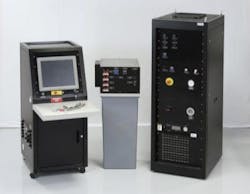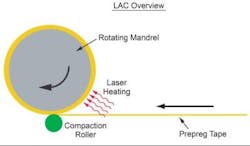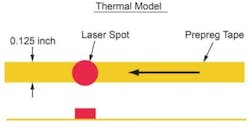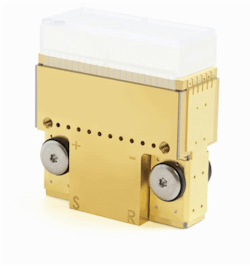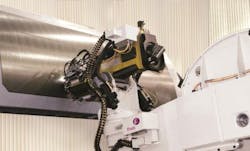ERIC GRALD and JOHN GOINGS
Laser system reduces cycle time and laminate rework
Large-volume Department of Defense (DoD) aerospace programs utilize automated fiber placement (AFP) and automated tape placement (ATP) machines to lay up large area structural composites using toughened bismaleimide (BMI) resins. The BMI prepreg composite is placed onto a tool, often over a period of several days, and then the component is bagged and cured in an autoclave to produce the part.
Current fiber placement machines operate in large, open factories at room temperature. The BMI resin most commonly used in AFP has relatively poor tack at room temperature, leading to slower laminating speeds and the need for considerable manual rework. Current approaches to achieve the heating step (hot gas jets or large multi-kilowatt infrared [IR] heaters) limit prepreg feed rates, offer no control of the thermal profile, are thermally inefficient, and lead to significant AFP downtime. The ability to increase prepreg feed rates to the maximum possible associated with the AFP system would dramatically reduce overall production costs. Increased control of the thermal profile will eliminate hand-rework operations associated with unique geometric features.
The Integrated Laser-Assisted Consolidation System (ILACS; FIGURE 1), developed by Creare LLC (Hanover, NH), uses fast-responding free-space (non-fiber coupled) semiconductor laser diodes as the heat source. This alternative heating method leads to markedly improved thermal efficiency, as direct diodes enable precise control of the heating profile. Developed under a SBIR Phase II program directed by the US Air Force, the ILACS design involved retrofitting an existing AFP system at Albany Engineered Composites (Salt Lake City, UT) with a free-space direct semiconductor laser diode heat source. This represented the first preproduction demonstration of advanced laser technology within an open manufacturing environment. Importantly, the ILACS included integrated noncontact temperature feedback control, which eliminates the need for preproduction testing that is common for open-loop IR and hot gas heating systems.
An overview of the layer-by-layer consolidation process is shown in FIGURE 2, where prepreg tows are heated to the prescribed temperature just prior to consolidation by a rotating mandrel. By using targeted laser heating, high rates of composite prepreg consolidation are achieved (up to 2400in/min.), representing a speed improvement of over 400% compared to AFP systems that use heated gas or provide feedback temperature control of the heating process. The feedback control directly controls the electrical current to the laser diodes and therefore optical power. Because heating is only delivered to the prepreg, unwanted parasitic heating of the AFP head is minimized, which reduces AFP downtime and increases overall productivity. High-density laser diodes, combined with miniaturized temperature sensors, lead to a compact system that can directly replace existing heating systems without impacting the overall AFP processing envelope.
Customer-driven requirements mandated that the size and shape of the new laser-based system fit within the fixed envelope of the current heating systems. Laser energy delivered via fiber-coupled laser diodes were initially considered—these types of diodes deliver light from the semiconductor diode via a flexible passive-core fiber. To achieve the necessary optical energy distribution across the processing area, secondary optics would also be required. Given the volumetric constraints of the heat source and the desire for higher electrical-to-optical efficiency, the use of fiber-coupled laser diodes was rejected. Using attached micro-optics for collimation, free-space direct diodes provide the desired beam divergence while providing an electrical-to-optical efficiency over 60%.
The final system design includes four tap-water cooled T6 diode stacks from Lasertel (Tucson, AZ)—the T6 laser diode heat source is shown in FIGURE 3. The T6 stacks were chosen because they were the only laser packages that would produce the power level required while fitting into the available physical space. The customized spacing between the bars was configured so that up to 2000W of optical power could be evenly distributed across the work surface. The electrical path was configured to allow each stack to be powered individually based on the number of prepreg tows being processed. The composite material temperature is actively monitored by the system and a closed-loop system controls the current to each diode, allowing for the power to be adjusted accordingly. The laser system delivers heat in a focused area and allows quick on/off operation.
As with all laser-based technologies, safety is a primary driver in the design. The laser emissions are purposefully diverging to optimize heat flux requirements while maximizing operator safety. The system includes light curtains that clearly demarcate the nominal hazard zone (NHZ) and shuts down the system if an operator enters the NHZ. The operator stands outside of the NHZ or the system automatically prevents all optical light output. Extensive analysis and testing was conducted to support the selection of nonreflective materials for construction of the system. Safety functions for the laser heat source are integrated into the overall machine safety system.
The human machine interface for ILACS is integrated into a standard terminal for the AFP. The operator can simply set the desired consolidation temperature and the fully automated system provides temperature control during production. With ILACS, it is possible to fabricate large-scale panels from CYCOM 5250-4 materials that are void-free after full cure, as verified by ultrasonic nondestructive inspection. The system can be fielded for a similar "total ownership cost" as the current IR lamp-based system, while offering significantly enhanced performance. Likewise, the higher performing heat source and system controls can be retrofitted into existing AFP systems, such as the Fives Machining Systems (Saint-Laurent-les-Tours, France) VIPER-6000 FPS (FIGURE 4).
ILACS was successfully demonstrated during the fabrication of an F-35 Carrier Version Lower Wing Box Skin. Data from ILACS was compared to the performance of an IR heating element.
Key results from this comparison are:
- Differential scanning calorimetry measurements of ILACS-processed material samples demonstrated no significant cure advancement caused by ILACS, a critical finding that supports the efficacy of the new system.
- Using ILACS, a 38% decrease in AFP cycle time was demonstrated and post-AFP laminate rework was reduced by 47%. While not all of the reduction in rework may be attributed to the laser heater, the minimization of the heat-affected zone produced by the laser is a significant factor.
- ILACS demonstrated an improvement in generated tack at all speeds. Materials that were more than 50% beyond their allowable working life limit were successfully fiber-placed, and remained well consolidated more than three weeks after application. The out-of-date material was fiber-placed at a 100% feed rate override. Neither of these results would be possible with the IR heater.
ILACS development was funded through a combination of SBIR and Office of the Secretary of Defense funding from the US Navy (NAVAIR), the US Army (Benet Laboratories), and the US Air Force Research Laboratory (Wright Patterson Air Force Base).
ACKNOWLEDGEMENTS
ILACS is a trademark of Creare LLC and CYCOM is a registered trademark of Cytec.
ERIC GRALD ([email protected]) is the business development manager for Creare LLC, Hanover, NH, www.creare.com; andJOHN GOINGS([email protected]) is a key account manager at Lasertel, Tucson, AZ, www.lasertel.com.

